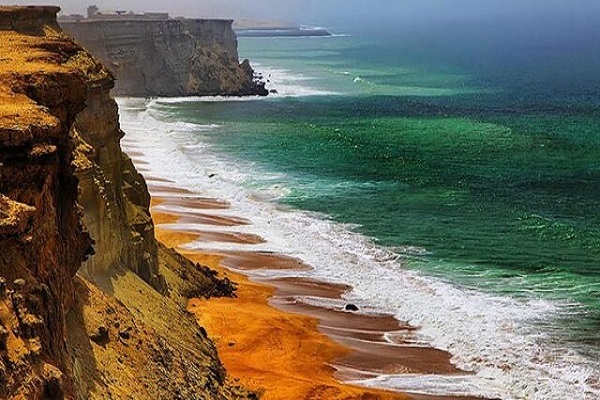
TABNAK, Nov, 02: Makran is a historical region in Iran that runs from mountains west of Jask all the way to parts of Pakistan's Baluchistan province in the southwest along the Sea of Oman.
However, Zionist regime has been raising the idea of IMAC Corridor project as a competitor to Iran's North-South Corridor, commonly known as International North-South Transport Corridor (INSTC). But it seems that the Zionist project sought to create a new route from Asia to Europe was thwarted by Resistance’s front moves.
Zionist regime on the other hand is keeping financial support of terrorist groups, including Jaish ul-Adl to make this economic area insecure as its proposed transit road failed.
Makran, golden transit opportunity for Iran
The importance of Makran region was raised by Iran’s Supreme Leader Ayatollah Khamenei in 2008, for the first time. Since then, the development of Makran region has always been discussed.
Loading and transporting 15 million tons of goods per year through international corridors, expanding existing settlements and cities, building new cities with a population of 2.5 million people, developing cultural and educational infrastructure, producing and transmitting 17 thousand megawatts of electricity, supplying and transferring 3 million cubic meters of water for drinking, agriculture and industries, providing 4050 beds in clinical centers and establishing 5 economic driving zones, developing oil, gas and petrochemical, mining and tourism industries, fisheries and agriculture, shipbuilding and port support, electronic industries and transportation are among the goals of Makran region 5-year plan.
According to experts, Makran is defined not in the east-west corridor but in the north-south corridor. There are three routes from north to south corridor. The first one is the one starting from northern Iranian ports, namely Astara, Anzali, Nowshahr, Fereydunkenar and Amirabad and is connected to Bandar Abbas by railways. This transit route is good for Russia.
The other route is the Caucasus route, which is connected from Miandoab (northwestern Iran) to Kermanshah (western Iran), so that Turkey can its transit goods to Imam port (southern Iran) from there. The third route is from Chabahar port to Sarkhes City, which becomes the eastern branch of the north-south corridor. Makran are highlighted in this direction.
All the countries of the Indian Ocean, Central Asia and Eastern Russia can benefit from Makran. For example, India supplies a large amount of its coal from Russian mines. Central Asian countries export raw goods and import products to Europe, so the goods are mostly exported through northern and southern ports of the corridor.
However, Acivating Sarakhs-Chabahar Corridor is of great importance. Consequently China and India can be connected to Central Asia, Russia and Europe through the Chabahar port, and the added value of this corridor through the coast of Makran includes Iran.
All these ideas need further development of Makran infrastructure as well. Jask and Chabahar ports are located in Makran. Chabahar itself has two main ports, including Shahid Kalantari and Shahid Beheshti.
Shahid Beheshti Port is located in eastern Strait of Hormuz. Presence of Persian Gulf countries in the area can be fruitful as well. The UAE has a company called DP World working in goods transit. The company makes huge investments in the Central Asian area and no country except Iran can have this advantage of being able to transfer the goods of the company from its own territory.
But it depends on which Persian Gulf countries are willing to use Iranian ports including Bandar Abbas, Shahid Rajaei Port, Bushehr Port, or Ganaveh Port.
Each of these ports is important in the Persian Gulf. So Iran will be able to persuade the countries to use Shahid Beheshti port for goods transit.
Makran to seriously confront Zionist IMEC corridor
The Zionist Corridor of India-Middle East-Europe-Israel (IMEC) has increased most Arab countries’ desire to normalize relations with the Zionist regime as it creates economic, security and logistic bases.
The corridor is specially supported by India and the United States of America. Of course, "Al-Aqsa storm operation" and the military confrontation of "Axis of Resistance" against the Zionist regime, developing relations between Iran and the countries of the axis of resistance and probable launch of Iran-Iraq-Syria corridor and insecurity in Israeli ports by the axis of resistance have caused a stop in IMEC corridor.
Of course, Iraqi and Syrian actors are still not able to exploit this new equation. At the same time, considering the economic attraction of trade and economic relations with Russia for Indians on the one hand and the American strategy to seriously confront the Iran-Iraq-Syria corridor on the other hand, it is expected that India's priority for economic cooperation with Iran will be focused on the North-South corridor, and Iran-Iraq-Syria corridor would not be attractive for India.
Consequently and according to Chabahar Port development agreement between Iran and India, Makran region can be considered as the key corridor of the country in opposition to the Zionist IMAC transit route.